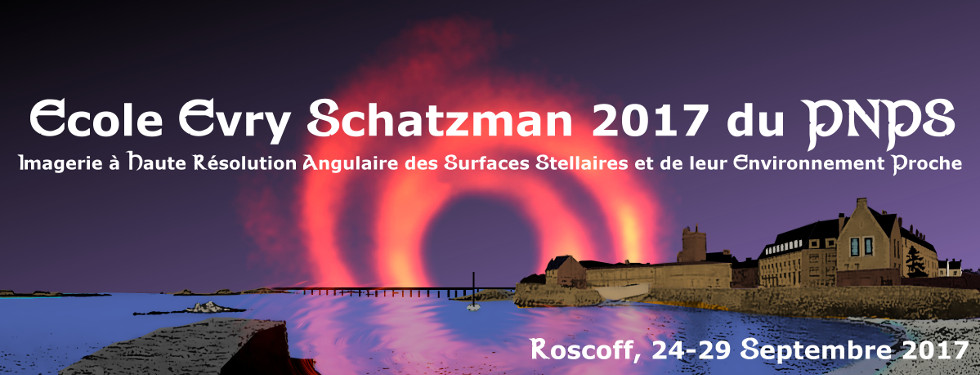Imagerie à Haute Résolution Angulaire des Surfaces Stellaires et de leur Environnement proche
Roscoff, 24 - 29 Septembre 2017

PROGRAM ORGANIZERS PARTICIPANTS CONCLUSION
The 2017th edition of the Evry Schatzman school (EES17) of the French national program of stellar Physics (PNPS) held in Roscoff (France) from 24 to 29 of September (https://hraetoile2017.sciencesconf.org/program). This school focused on high angular resolution imaging. High angular resolution is a thriving theme with many operating instruments such as SPHERE, JWST, but also long-term projects, like EELT. It concerns monolithic telescopes, but also interferometric techniques with for instance, PIONIER (VLTI), MIRC (CHARA), VEGA (CHARA), GRAVITY (VLTI), MATISSE (VLTI) ..., or at longer wavelengths ALMA and NOEMA. All these instruments with their specific angular resolution, their wavelength coverage and spectral resolution, are essential for studying star formation regions, protoplanetary discs, as well as the surface and environment of stars. High angular resolution imaging is a priority theme for the National Program for Star Physics (PNPS). But, it is also essential for the study of extrasolar systems, a unifying theme of the National Planetary Program (PNP).
The area of "High Angular Resolution" is today structured in France by the ASHRA (Action Spécifique pour la Haute Résolution Angulaire) specific action. All the themes of the High Angular Resolution tend towards a single objective: the control of the wavefront to reach the limit of resolution. Around this objective, the discipline has been regularly enlarged by the successive apparition of several topics during its history: optical interferometry, adaptive optics, very high dynamics, signal processing, not forgetting the study of atmospheric turbulence and the development of innovative optical concepts.
The impact of optical interferometry on, for example, stellar physics (but not only) is extremely diverse. We can mention the determination of fundamental stellar and planetary parameters, asteroseismology, the distance of Cepheids, the study of protoplanetary disks, fast rotators and the convective structure of supergiant stars. Interferometry has produced images since about 2009. At the same time, thanks to the development of adaptive optics, it is now possible to directly image with monolithic telescopes (such as NACO at VLT, for example) the very close environment of giants and red supergiants (like Betelgeuse or L2 Puppis), highlighting, for each of these stars, a nebula of gas and dust. SPHERE is currently producing similar results. In the longer term, direct imaging of the stellar surface will be possible with the ELT, leading to a better understanding of stellar convection, the environment of massive or evolved stars together with their loss of mass, etc.
This high angular resolution theme requires state-of-the-art instrument expertise, which must take into account a whole range of technical as well as scientific constraints. The rapid evolution of this theme in the world of stellar and planetary physics poses the problem of good communication between several communities: high angular resolution instrument designers on the one hand and their users on the other, i.e. astro-physicists and/or exo-planetologists, for instance. This school thus aimed first and foremost to bring these two communities closer together. But, there is also strong emerging synergies between the different techniques of imaging: monolithic telescopes versus interferometry, optical versus radio observations, and we can also mention, for instance, the fruitful complementarity of interferometry and asteroseismology, in order to determine the fundamental parameters of stars. The school aimed indeed at clarifying these synergies. It was also a matter of 'democratizing' the high angular resolution techniques in order to make this theme more accessible to the entire 'stellar' and 'planetary' community.
Program
The school wasstructured around 5 key lectures, organized as followed:
- History and introduction to the technique,
- An overview of existing and forthcoming instruments,
- A description of the most spectacular astrophysical applications,
- All this was completed by personal labwork (TP)
Part I: Direct imaging
- Lecture - Introduction to direct imaging (F. Martinache) :
 video,
video,  slides1,
slides1,  slides2,
slides2,  slides3
slides3 - TP on atmospheric distortion and image analysis techniques (F. Martinache)
- Lecture - Current instrumentation and future with direct imaging (A. M. Lagrange, E. Lagadec) :
 video1, video2
video1, video2 - TP on reduction and analysis of SPHERE data (E. Lagadec)
Part II: Interférometry
- Lecture - Introduction to interférometry. History, principles (J. Surdej) :
 video,
video,  slides
slides - Lecture - Optical interferometry. Current and forthcoming instruments and their specificities (D. Mourard) :
 video,
video,  slides
slides - TP on « Jean-Marie Mariotti Center » (JMMC) tools. Data reduction and image reconstruction with GRAVITY (A. Meilland, F. Millour)
- Lecture - Radio/mm interferometry. Current and forthcoming instruments and their specificities (A. Maury):
 video
video
Specific seminars spécifiques:
- Seminar on E-ELT (D. Mourard):
 slides
slides - First results from Gravity. Perspectives. (P. Kervella, UMi) :
 slides
slides
Organizers
Scientific Organising Committee
- N. Nardetto (OCA, chair)
- Y. Lebreton (LESIA, Observatoire de Paris)
- E. Lagadec (OCA)
- A. Meilland (OCA)
Local Organising Committee
- N. Nardetto (OCA, chair)
- Y. Lebreton (LESIA, Observatoire de Paris)
- E. Lagadec (OCA)
- A. Meilland (OCA)
- G. Mella (IPAG)
- I. Lapassat (OCA)
Participants
This EES17 school gathered 38 participants, including 1 master student, 20 doctoral students, 3 post-docs, 1 computer engineer, and 13 researchers, including 10 speakers/organizers. The proportion of students and post-docs was therefore significant (around 63\%). On the other hand, the school was rather national with 7 participants coming from European laboratories.
https://hraetoile2017.sciencesconf.org/resource/listeparticipants
Conclusion
A book is in preparation. We hopt it will help students but also engineers and researchers to get familiar with this topic of high angular technique and astrophysical applications. High angular resolution techniques are generally very sharp and require a constant effort of pedagogy. This role is currently played in France by the Jean-Marie Mariotti Center (JMMC):
Beyond pedagogy, this school helped to identify several synergies that we anticipate in the future:
- the combination of direct visible imaging and radio interferometry that allow to superimpose images at different wavelengths and, very interestingly, with the same angular resolution (case of the AGB star L2 Pup);
- interferometric and Doppler imaging, which both allow to see the spots on the surface of stars (case of Betelgeuse), or for instance, Doppler imaging and velocimetry in order to detect exo-Jupiters (case of the Tauri V830 Tau);
- direct imaging and interferometry: for example, detection of exoplanets by imaging with SPHERE and determination of the interferometric diameter of the host star to determine the age of the system (case of GJ504);
- the interferometry in the continuum and in a spectral line (Halpha for example) to probe both the geometry and the kinematics of the studied object (case of the Be star phi Per, but also of young stars);
- the complementarity of interferometry and asteroseismology for the determination of stellar and planetary parameters.
These synergies were discussed during the PNPS prospective of 2018 in Montpellier, and a new transverse topic was created. It was defined that a stellar object becomes prototypical when it faithfully represents a class of objects, and if, one or more of the methods describes above can be used together to better understand its physics (eg $ \beta $ Lyrae for interactive binaries, $ \delta $ Cep for Cepheids, etc ...). Conversely, when one compares methods of analysis (model of atmosphere or evolution, for example) on test stars, one will speak of {\it benchmarks} star. These crossed approaches constitute the heart of the new emerging theme of the PNPS: "Synergies of methods: focus on prototypical objects, {\ it benchmarks}, ...".
https://pnps2018.sciencesconf.org/





